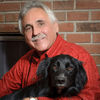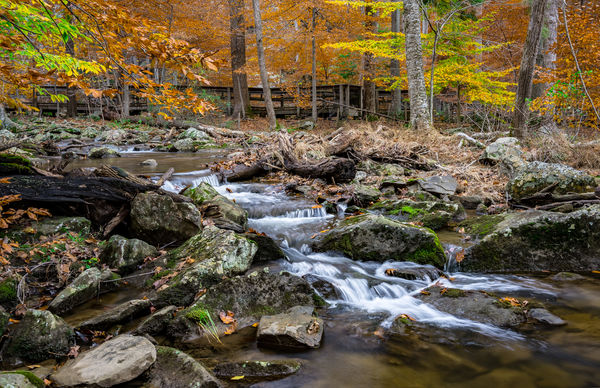Setting aperture and shutter speed - the active vs. the passive approach
Nov 15, 2018 07:28:20 #
steve49 wrote:
I start w shutter speed myself. while watching iso in the background.
From time to time in the past I have used P but sometimes found it came up with what I thought were odd choices...
like 1 /2,000 and f 4 or something on a daylight shot. Not always but often enough for me to begin to question the program. It would be interesting to hear an explanation by an actual programmer.
From time to time in the past I have used P but sometimes found it came up with what I thought were odd choices...
like 1 /2,000 and f 4 or something on a daylight shot. Not always but often enough for me to begin to question the program. It would be interesting to hear an explanation by an actual programmer.
The choices the camera makes in auto mode are all based on the internal light meter. And sometimes it cannot make the best choice due to where the photographer has pre focused and also due to uneven lighting throughout the frame; also focusing points set on camera.......there are alot of reasons.
Nov 15, 2018 07:45:02 #
roxiemarty wrote:
I found this easy exposure triangle years ago when I was still struggling to "get it!" I found it very helpful, and thought I would share. This is a very interesting discussion, Linda.
Is the triangle supposed to be an equilateral triangle?
Nov 15, 2018 07:49:09 #
For Richard--I hope you noted the middle finger on the hand holding the drink. I think she was trying to tell you something, but it may simply have been related to what she is drinking.
Linda, thanks for getting this started. It is a helpful reminder on many facets of our complex love for photography.
Linda, thanks for getting this started. It is a helpful reminder on many facets of our complex love for photography.
Nov 15, 2018 07:53:42 #
BebuLamar wrote:
Is the triangle supposed to be an equilateral triangle?
It is just an example, a reminder of the cause and effect of various settings, and how they work together.
Nov 15, 2018 08:06:45 #
Linda From Maine wrote:
The active approach is to b first /b choose the ... (show quote)
You have certainly started a fine discussion thread! i have to respectfully disagree with your premise in that backward thinking is still active decision making and therefore an active approach. I would consider anything other than snap shots to be an active approach.
In other words, any forethought given as to A, S, or ISO is an active approach. And for me, that extends to lens selection, often the camera selection and even the decision to set up a tripod. Are those three decisions any less active?
Edit: While I am at it, why not throw in metering mode and focus point selection method?
Nov 15, 2018 08:08:18 #
roxiemarty wrote:
I found this easy exposure triangle years ago when I was still struggling to "get it!" I found it very helpful, and thought I would share. This is a very interesting discussion, Linda.
One thing that is left out usually is the direction for adjustment. Assuming one gets the three readings for an average shot, for every "click" on the scale, there has to be a corresponding "click" on either of the other two sides. I.e., one click to the right for the ISO, One click up on the shutter side or one click down on the aperture side. This maintains the basic ratio to work from. It is not a hard and fast rule, but it will help keep one from getting "lost".
Nov 15, 2018 08:18:06 #
gvarner
Loc: Central Oregon Coast
I’m an inveterate snap shooter so I use Program mode. It’s like music - I like to listen to music but I don’t create music. Sometimes I’ll fiddle with the volume or base or treble or balance to get the sound that I prefer. But overall, I just listen.
Nov 15, 2018 08:37:23 #
I sort of subscribe to your methodology. By that I mean, if I am shooting BIF and need to keep the shutter speed above 500, I set to shutter priority and set the speed thus.
However, when I am shooting a waterfall, I will just stop down (aperture) until I hit the slow speed I need for blur.
However, when I am shooting a waterfall, I will just stop down (aperture) until I hit the slow speed I need for blur.
Nov 15, 2018 08:44:00 #
IDguy wrote:
Thanks for your information. I don't recall that my old Canon sx50 had the option to select from sets, but that's a nice feature! I did use P with that camera for the exposure compensation ability. With a bridge camera where f/8 is not only the smallest aperture available, but also provides more dof than you might want at most of the f/stops, aperture priority was kind of wasted space. For all Nikons and I believe others that use the designation P mode allows you to rotate the thumbwheel over the range of shutter speed / f-stop combos that satisfy exposure for the selected ISO...
LarryFB wrote:
Thanks for your participation, Larry, and for the compliment! Within the limits of my personal experiences, I "mostly" try to be an asset Per your definitions, I guess I usually shoot active because I typically select a mode that provides what I'm looking to achieve... I appreciate your posts and your comments...

Stephan G wrote:
Well said, thanks Stephan.Like with any tool, we all have to come to some understanding as to the basic functions of the tool. How we acquire it is as varied as to each person. The common path involves time and comprehension. "Do it" is a good way to go... At times, new technology makes newbies of all of us.
danersmiff wrote:
Very interesting and educational approach. Thanks so much for your time.When I go on location to shoot, I let the camera "talk to me" ...
Jimmy T wrote:
Glad you enjoyed the challenge, Jimmy I concur completely unless a tripod or flash is involved. Then again, outside, I . . . .darn. It just never ends, grin. Great question Linda! 

 Also, glad you mentioned flash, Maybe someone would want to expand on that because I've only used twice in a decade, I think.
Also, glad you mentioned flash, Maybe someone would want to expand on that because I've only used twice in a decade, I think.roxiemarty wrote:
Roxie, I'm so glad you're enjoying the thread, and thank you for that charming Mickey triangle! And after Bebu questioned, I actually measured on the screen, lol. Equilateral triangle it is! And usually presented this way to indicate that if you change one setting on one side, you must change a setting on another side to keep the same exposure (keep the triangle from falling over). Stephan G explains further here.I found this easy exposure triangle years ago when I was still struggling to "get it!" I found it very helpful, and thought I would share. This is a very interesting discussion, Linda.
steve49 wrote:
I see that Roxie has offered some information on that. I had similar issue with one camera, I forget now, but it would lower the shutter speed far too much while barely touching the ISO. Thanks for commenting in the thread!From time to time in the past I have used P but sometimes found it came up with what I thought were odd choices...It would be interesting to hear an explanation by an actual programmer.
tennis2618 wrote:
So glad you're enjoying, thank you!Linda, thanks for getting this started. It is a helpful reminder on many facets of our complex love for photography.
mikeroetex wrote:
Very well said, thank you!I have to respectfully disagree with your premise in that backward thinking is still active decision making and therefore an active approach. I would consider anything other than snap shots to be an active approach...
gvarner wrote:
There are a lot of musicians on this site and even more who listen to music while editing - and are very selective about what goes with what they're editing!I’m an inveterate snap shooter so I use Program mode. It’s like music - I like to listen to music but I don’t create music. Sometimes I’ll fiddle with the volume or base or treble or balance to get the sound that I prefer. But overall, I just listen.
Simply "taking pictures" can be a fulfilling and pleasurable hobby. And if these photos of yours are any indication, you find much beauty in the world around you.
rond-photography wrote:
The hybrid approach I sort of subscribe to your methodology. By that I mean, if I am shooting BIF and need to keep the shutter speed above 500, I set to shutter priority and set the speed thus. However, when I am shooting a waterfall, I will just stop down (aperture) until I hit the slow speed I need for blur.
 Thanks so much for your participation.
Thanks so much for your participation.Nov 15, 2018 08:53:55 #
I pretty much operate as you describe Linda. I always shoot RAW and decide what I want out of a series of shots, maybe its determining shutter speed for say BIF or aircraft, then what DOF I want, so that establishes aperture, finally i have to find the lowest ISO to use for a given situation. Very occasionally I may select auto ISO.
Nov 15, 2018 08:57:06 #
Linda
Early on is my resumption of photography as a hobby, and getting into digital, the mantra was to shoot manual(period)! So that's what I got myself to doing and for each scene I set each of the three - A, S & ISO - in expectation of the result that I want. I look at the result and change what I want to change.
At times when I'm lazy, don't care or when acknowledging that for this scene the camera will likely do a better job than I will given the effort I may need to exert I'll put something or everything to automatic. BTW - (and I mention this SOLELY to stress the importance of the camera's settings for the scene to be recorded NOT to reopen the argument) I am a confirmed jpg shooter meaning I don't have, nor do I want the "flexibility" shooting raw would give for PP.
Early on is my resumption of photography as a hobby, and getting into digital, the mantra was to shoot manual(period)! So that's what I got myself to doing and for each scene I set each of the three - A, S & ISO - in expectation of the result that I want. I look at the result and change what I want to change.
At times when I'm lazy, don't care or when acknowledging that for this scene the camera will likely do a better job than I will given the effort I may need to exert I'll put something or everything to automatic. BTW - (and I mention this SOLELY to stress the importance of the camera's settings for the scene to be recorded NOT to reopen the argument) I am a confirmed jpg shooter meaning I don't have, nor do I want the "flexibility" shooting raw would give for PP.
Nov 15, 2018 09:23:20 #
Jolly Roger wrote:
Thanks so much for commenting. I love auto ISO I pretty much operate as you describe Linda...Very occasionally I may select auto ISO.
 Steve Perry did a video on how he uses (under what conditions):
Steve Perry did a video on how he uses (under what conditions): https://backcountrygallery.com/manual-mode-with-auto-iso/
BboH wrote:
In manual mode, do you always set the 3 components in the same order, or do you vary that based on the subject? Are you primarily a landscape shooter?... I set each of the three - A, S & ISO - in expectation of the result that I want. I look at the result and change what I want to change...I am a confirmed jpg shooter meaning I don't have, nor do I want the "flexibility" shooting raw would give for PP.
Regarding preference of jpg over raw, IMO too often on this site new users are urged to get into raw when they may already be feeling overwhelmed by what they don't yet know about the camera or exposure. As for quality of results, check out one the links in my signature to see where I stand on "what's important in a photograph and what isn't"

Nov 15, 2018 09:29:48 #
BebuLamar wrote:
I would love it if camera maker allow me to program the full AUTO mode myself. I know very well how I would approach to these settings and if I can put my algorithm in the camera I would use it almost all the time. I actually like automation because my job is to automate industrial production machines. However, I ended up using my camera in manual mode so often because I just can't make it to work my way.
On the surface this sounds like a good idea; however, no algorithm, yours or anyone else's can apply to all situations.
While I don't use full Auto, I am an experienced photographer and have played around with Auto out of curiosity (Canon 77d). I've found that it does a relatively good job most of the time, but a computer can't read your mind or understand your subject or how you intend to treat that subject.
No fixed algorithm can anticipate situations requiring a particularly fast shutter speed or a demanding aperture requirement.
A good learning tool is to take shots in Auto and examine the histogram and other exif data. This can help the inexperienced get a feel for exposure settings as they relate to subject and lighting.
My own personal preference is aperture priority with auto ISO followed by EC if necessary.
M. Goldfield
Nov 15, 2018 09:30:38 #
mizzee
Loc: Boston,Ma
I think about what I want to achieve. I do very little action photography so I’m almost always in aperture priority. If I’m trying to isolate my subject, I’ll go for a bigger aperture. If I’m going for the big picture like a landscape or a portrait with some context, then a smaller aperture. If I’m not on a tripod (which is most of the time), next I’ll adjust my iso to a point where I can safely hand hold. Because my Oly is live view all the time, I can see what I’m going to get before I shoot. This lets me fine tune with EC, etc. I don’t worry much about noise as my images aren’t going to appear on a bus.
Nov 15, 2018 09:34:06 #
Good discussion, Linda. I believe there is at least one more option that I have not yet seen and that is shooting HDR in high contrast circumstances. Usually I do this tripod mounted and establish depth of field needed via aperture priority keeping ISO generally low and varying shutter speed to get usually three exposures. Base exposure as metered then two stops over and two under. Merge in LR using auto align but not auto tone and then go to work in lightroom. Sample attached.
If you want to reply, then register here. Registration is free and your account is created instantly, so you can post right away.








